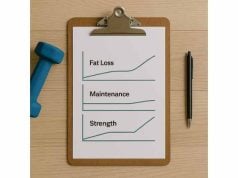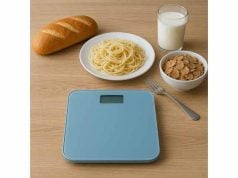When fat loss slows, most people slash calories and hope for the best. That often backfires: hunger climbs, daily movement drops, training suffers, and progress stalls harder. The fix is more precise. First, confirm you are in a real plateau with structured tracking. Then make small, testable changes to calories and macros while protecting protein, steps, sleep, and training quality. The goal is not a perfect spreadsheet; it is a repeatable decision process you can run every two weeks. Keep our concise plateau troubleshooting guide open as you work through the steps below.
Table of Contents
- Confirm a true stall
- How to adjust calories and macros
- Pick your calorie drop
- Protein, carbs and fats
- Hidden stall drivers
- When to pause or raise
- Templates and examples
- Frequently Asked Questions
Confirm a true stall
Before you change anything, verify that fat loss has actually stopped. Water, glycogen, sodium, alcohol, and menstrual cycle shifts can mask real progress for days. Your first job is to smooth that noise and test adherence—not to cut more calories.
Use 7-day averages, not single weigh-ins
- Weigh daily under the same conditions (after bathroom, before eating).
- Compare this week’s 7-day average to last week’s 7-day average.
- A flat or slightly higher average across 2–3 consecutive weeks—with solid adherence—is a legitimate stall.
Add a waist check to confirm
- Measure the navel circumference once per week, same tape, same posture, same time.
- If waist and 7-day weight averages are both flat for 2–3 weeks, treat it as a stall.
Audit the inputs (no judgment, just data)
- Calories: Are you within ±100–150 kcal of target most days? Weekend “extras” can erase a weekday deficit.
- Protein: Hitting 0.7–1.0 g per lb of goal body weight keeps you fuller and preserves lean mass.
- Steps (NEAT): Did your weekly average drop >1,000–1,500 steps/day vs. last month?
- Sleep: Fewer than 7 hours on most nights increases hunger and snack bias.
- Sodium and alcohol: Two salty takeout meals or a few drinks can elevate the scale for 3–5 days.
What counts as “good enough” adherence?
- Calories: ≥5 of 7 days on target; the other 2 within ~200 kcal.
- Protein: ≥5 of 7 days at target.
- Steps: Weekly average within 1,000/day of your baseline.
- Training: You completed the planned sessions with steady effort.
If you have never reviewed fundamentals, skim our concise fat-loss basics so your adjustments sit on a solid foundation.
Bottom line: Do not rush changes. Confirm a true stall across 2–3 weeks with 7-day averages, a waist check, and a quick audit of calories, protein, steps, sleep, sodium, and alcohol.
How to adjust calories and macros
Once you are certain it is a stall, change one lever at a time for 10–14 days. This keeps the process measurable and prevents over-restriction.
A simple 14-day adjustment plan
- Keep protein fixed. Target 0.7–1.0 g/lb of goal body weight. Protein is not your cutting fuel; it is your insurance against muscle loss and overeating.
- Trim or add, not both. Choose one: a small calorie drop or a step increase.
- Prefer small calorie trims. Reduce 100–150 kcal/day (about 3–5% of intake). Remove from the easiest place you will not miss: added fats in cooking, dessert portions, or “handful foods.”
- Use carbs as your variable fuel. If training quality is poor, reallocate rather than remove: pull 50–75 g carbs/week from non-training windows and add 25–40 g around sessions.
- Guard fats from going too low. Most do well with 0.3–0.5 g/lb body weight as a floor.
- Raise steps if you prefer movement. Add 1,500–2,000 steps/day on average (15–20 minutes of brisk walking).
- Hold the new plan for 10–14 days. Compare 7-day averages and the waist again. If trending down, keep going. If not, try the alternate lever.
What to adjust first?
- Great training, high hunger: Trim 100 kcal from fats; keep training carbs.
- Poor training, flat hunger: Keep calories steady; move 25–40 g carbs into the 3–4 hours around training.
- Weekend overages: Keep weekdays unchanged; pre-log a higher-calorie weekend meal and shave ~300 kcal earlier in the day to fit it.
Precision without obsession
- Think in portions, not grams:
- 100 kcal ≈ 1 tbsp oil, 1 small handful nuts, ½ cup cooked rice, or 1 slice of most breads.
- 25 g carbs ≈ 1 medium fruit, 1 small wrap, ¾ cup cooked potato.
- Keep your meal count and times the same. Changing when you eat often hurts adherence more than altering how much.
When you want a clean checklist of quick wins before cutting harder, browse our concise twelve fixes and pick the one that fits your sticking point.
Bottom line: Adjust one variable for 10–14 days—a 100–150 kcal daily trim or +1,500–2,000 steps/day—while holding protein steady. Reassess with 7-day averages and a waist check.
Pick your calorie drop
Large cuts feel decisive; small cuts get results. Your body pushes back against big deficits by reducing spontaneous movement and amplifying hunger. Start with the smallest effective change and let time do the work.
How much should you cut?
- Gentle trim (–100 kcal/day): Best first step. Almost invisible to hunger, easy to sustain.
- Moderate trim (–150–200 kcal/day): Use if you have already tested a gentle trim for two weeks without change and adherence is excellent.
- Bigger cuts (–250–300 kcal/day): Short-term only. Reserve for people who prefer movement increases instead (e.g., +2,000–3,000 steps/day) or who need a brief push with strong guardrails.
Where to remove calories
- Added fats: oils, butter, mayo, nut butters (calorie-dense, low fullness).
- Refined extras: pastries, chips, creamy dressings.
- Portion edges: trim the edges of starch portions, not the whole meal (e.g., ¾ cup cooked rice instead of 1 cup).
Protect your anchors
- Protein: hold the line; it controls hunger and protects lean mass.
- Vegetables and fruit: keep volume foods for satiety.
- Training carbs: keep 25–40 g before lifting and 25–40 g after to preserve performance.
Rate of loss targets
- Aim for 0.5–1.0% of body weight per week as an average over a month.
- As you get leaner, expect the rate to slow; do not chase the early pace.
Examples
- 170-lb lifter, 2,200 kcal/day: try 2,100 kcal/day or keep 2,200 and add +2,000 steps/day.
- 210-lb lifter, 2,600 kcal/day: try 2,450–2,500 kcal/day, mostly by shaving oils and snack extras.
- 140-lb runner, 2,000 kcal/day: keep calories; move 40 g of daily carbs to the 2 hours pre- and post-run.
To track whether these trims are working without scale anxiety, use a consistent 7-day average approach like in our simple weigh-in protocol.
Bottom line: Start with –100 kcal/day or +1,500–2,000 steps/day. Keep protein and training carbs intact. Reassess after 10–14 days; only then consider another –100 kcal.
Protein, carbs and fats
You do not need perfect macros to lose fat, but the order of operations matters. Lock protein first, then place carbs to fuel training and steps, and let fats fill the rest.
Protein: your non-negotiable
- Target 0.7–1.0 g/lb of goal body weight (e.g., 140–200 g for a 200-lb person aiming for 180).
- Distribute across 3–5 meals with 25–50 g each.
- Prioritize lean sources you enjoy: poultry, fish, lean beef, eggs/whites, Greek yogurt, cottage cheese, tofu/tempeh, protein powders.
Carbs: your adjustable fuel
- Place 50–80 g of your daily carbs in the 3–4 hours around training.
- On rest days, you can pull 25–50 g from late evening to earlier meals to curb snacking.
- Choose mostly starches and fruit for performance; vegetables for volume and fiber.
Fats: your satiety buffer
- Keep a floor of 0.3–0.5 g/lb body weight to support hormones and absorption of fat-soluble vitamins.
- Use measured portions for oils, nut butters, cheese, and dressings so “just a drizzle” does not become +200 kcal.
Fiber and fruits/vegetables
- Target 25–40 g fiber/day, mostly from whole grains, legumes, fruits, and vegetables.
- Use high-volume sides (salads, roasted vegetables, broth-based soups) to make smaller calorie trims invisible.
Macro shifts that work during stalls
- Reallocate, do not remove: Move 25–40 g carbs into the training window before cutting them from the day.
- Protein bump for snackers: If evenings are your trouble spot, add 20–30 g protein at the prior meal; keep calories unchanged by trimming a small fat portion.
For a deeper cut-to-maintenance macro setup you can use beyond stalls, see our concise overview of maintenance macros and how to land on numbers you can live with.
Bottom line: Lock protein, time carbs to support performance and steps, and let fats fill the remainder above your personal floor. During stalls, reallocate carbs before you remove them.
Hidden stall drivers
Many “plateaus” are not calorie math problems; they are behavior and physiology problems. Fixing these often restarts progress without deeper cuts.
NEAT slippage (daily movement)
- As you diet, you naturally move less. Protect a step floor (e.g., 8–10k).
- Set two anchors: a morning 10-minute walk and a post-meal 10-minute walk. Most people hit +2,000 steps/day with these two.
Sleep debt
- Fewer than 7 hours or inconsistent bedtimes increase hunger and reduce dietary restraint.
- Guard a wind-down (lights down, screens off) for 30–45 minutes. A regular bedtime fixes more stalls than any macro tweak.
Sodium, glycogen, and water
- Salty meals, hard training, and menstrual phases can push the scale up for days.
- Look at weekly averages, not single spikes. Keep sodium roughly consistent day-to-day when you are evaluating changes.
Alcohol
- Alcohol contributes 7 kcal per gram and often carries extra snacks.
- Even 2–3 drinks/week can stall apparent progress by altering sleep and water retention. If the scale is noisy, run two alcohol-free weeks before cutting more.
Weekends
- A “small” surplus of 500–700 kcal on Friday and Saturday can wipe out a weekday –500 kcal deficit.
- Create weekend templates with a bigger lunch and a lighter dinner, or pre-log the social meal and adjust breakfast and snacks.
If steps are your usual casualty in a deficit, our practical notes on keeping daily movement up will help you lock a repeatable NEAT plan without living on a treadmill.
Bottom line: Fix movement, sleep, sodium consistency, alcohol, and weekend structure before you slash more calories. Most stalls crack here.
When to pause or raise
Sometimes the best adjustment is not a deeper deficit. If performance, sleep, or adherence are sliding, using maintenance calories for a short phase protects muscle and motivation so the next cut works.
Pause indicators
- 7-day averages and waist flat for 2–3 weeks with strong adherence.
- Strength drops >5% for two consecutive weeks.
- Sleep under 7 hours most nights despite effort.
- Mood and food noise rising; frequent unplanned overeating.
How to run a 1–2 week maintenance block
- Raise calories to estimated current maintenance (often +10–20% from your cutting intake).
- Keep protein high; add calories mostly from carbs to refill glycogen and improve training.
- Maintain step floor and training; push quality where it feels good.
- Expect a small water-weight bump in week one. Judge success by week-two averages, waist, and training—not day one.
When to raise calories inside a cut
- You chose an aggressive deficit and see rapid hunger, step collapse, and poor training.
- Bump intake +100–150 kcal/day and reallocate carbs to training.
- If fatigue remains high after a week, transition to maintenance for 7–14 days.
For a deeper dive on the counterintuitive times when more calories produce better net fat loss, see our practical overview of when to raise calories during a stall.
Bottom line: If the plan is breaking adherence and recovery, call maintenance for 1–2 weeks. Return to a smaller deficit and better training, and you will move faster overall.
Templates and examples
Abstract numbers help; concrete templates change behavior. Use these as starting points, then personalize.
Example A — Desk professional, 185 lb, lifting 3x/week
- Current intake: 2,200 kcal; protein 160 g; carbs 220 g; fats 70 g; 6–7k steps/day.
- Problem: Scale flat for 2 weeks; evening snacking.
- Adjustment (14 days):
- Keep protein 160 g.
- Trim –100 kcal by measuring oils and swapping a nightly 200-kcal snack for Greek yogurt + berries (150–180 kcal).
- Reallocate +25 g carbs to pre- and post-workout; pull them from late evening.
- Add a post-dinner 10-minute walk (≈ +1,200 steps/day).
- Outcome check: If 7-day average and waist move down, hold. If flat, consider –100 kcal more or +1,500 steps.
Example B — Busy parent, 150 lb, running 2x/week + circuits
- Current intake: 1,900 kcal; protein 120 g; carbs 200 g; fats 65 g; 8–9k steps/day.
- Problem: Weekend surplus; Monday water spikes.
- Adjustment (14 days):
- Keep calories 1,900 but pre-log Saturday dinner (~900 kcal).
- Build Saturday as two larger meals and a protein-heavy snack; shave breakfast 200 kcal to fit dinner.
- Keep alcohol to 0–1 drink; add 2× 10-minute walks after bigger meals.
- Outcome check: Averages settle; if still noisy, –100 kcal/day from weekday cooking fats.
Example C — Recreational lifter, 210 lb, aggressive cutter
- Current intake: 2,300 kcal; protein 190 g; carbs 180 g; fats 80 g; 10k steps/day.
- Problem: Strength down 5–7%, sleep poor, cravings high.
- Adjustment (7–14 days):
- Raise to maintenance (+250–300 kcal/day), mostly via carbs, keep protein.
- Keep steps and training; push performance.
- After week two, re-enter at 2,400–2,450 kcal/day (gentler deficit), with 25–40 g carbs around each session.
A weekly scorecard that takes 10 minutes
- Weight: 7-day average vs. last week.
- Waist: weekly.
- Protein: days at target.
- Steps: weekly average.
- Sleep: average hours and bedtime consistency.
- Training: did performance hold?
- Hunger (1–10): weekly mean.
Decision rules you can trust
- Two flat weeks + good adherence: adjust one lever (–100 kcal/day or +1,500–2,000 steps/day) for 14 days.
- Flat after two adjustments: run maintenance for 1–2 weeks.
- Performance/sleep collapse: raise calories now, not later.
Bottom line: Small, consistent changes—paired with a tiny weekly scorecard—beat overhauls. Make one adjustment, hold it for two weeks, and let the data make your next decision.
Frequently Asked Questions
How many calories should I cut when weight loss stalls?
Start small: –100 kcal/day for 10–14 days or add +1,500–2,000 steps/day. Reassess using 7-day weight averages and a weekly waist check. Only if both are flat should you consider another –100 kcal trim.
Should I change macros or just calories?
Lock protein at 0.7–1.0 g/lb of goal body weight. Adjust carbs first—reallocate 25–40 g around training—before removing them. Keep fats above 0.3–0.5 g/lb. If needed, trim 100–150 kcal/day from added fats or snack extras.
What if weekends keep ruining my deficit?
Pre-log the social meal, build the day around two larger meals, and trim ~300 kcal earlier to fit it. Hold protein high, keep post-meal walks, and limit alcohol to 0–1 drink. If averages remain flat, remove –100 kcal/day on weekdays.
How long should I test a change before switching again?
Hold each adjustment for 10–14 days. Compare 7-day averages and waist to the prior period. Changing everything weekly hides cause and effect and usually increases hunger without better results.
When should I pause the diet instead of cutting more?
Pause if strength drops >5%, sleep is poor, hunger is high, or both 7-day averages and waist are flat for 2–3 weeks with strong adherence. Run 1–2 weeks at maintenance, then return with a smaller deficit.
Do I need to hit exact macros to lose fat?
No. Hitting protein and calories matters most. Carbs and fats can flex to preference and training needs as long as fats stay above 0.3–0.5 g/lb and carbs support performance.
References
- Enhanced protein intake on maintaining muscle mass, strength, and physical function in adults with overweight/obesity: A systematic review and meta-analysis 2024 (Systematic Review)
- Effects of Experimental Sleep Restriction on Energy Intake, Energy Expenditure, and Visceral Obesity 2022 (RCT)
- Does adaptive thermogenesis occur after weight loss in adults? A systematic review 2022 (Systematic Review)
- International society of sports nutrition position stand: nutrient timing 2017 (Guideline)
- Effect of two different weight-loss rates on body composition and strength and power-related performance in elite athletes 2011 (RCT)
Disclaimer
This article provides general education about nutrition and weight management. It is not a substitute for personalized medical advice, diagnosis, or treatment. If you have medical conditions, take prescription medications, are pregnant or breastfeeding, or have a history of disordered eating, consult a qualified professional before changing your diet or training.
Share and follow
If this guide helped you troubleshoot a stall, consider sharing it with a friend who is adjusting their plan. For practical updates and new articles, you are welcome to follow us on the platforms you already use—Facebook, X, Instagram, or LinkedIn.

















